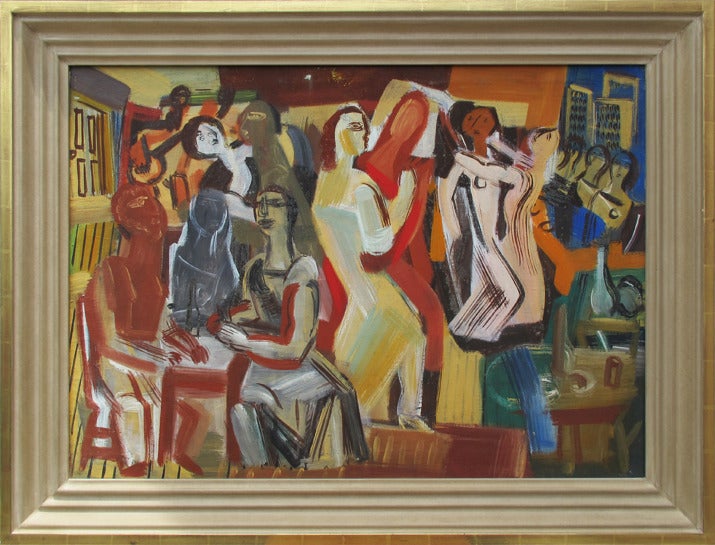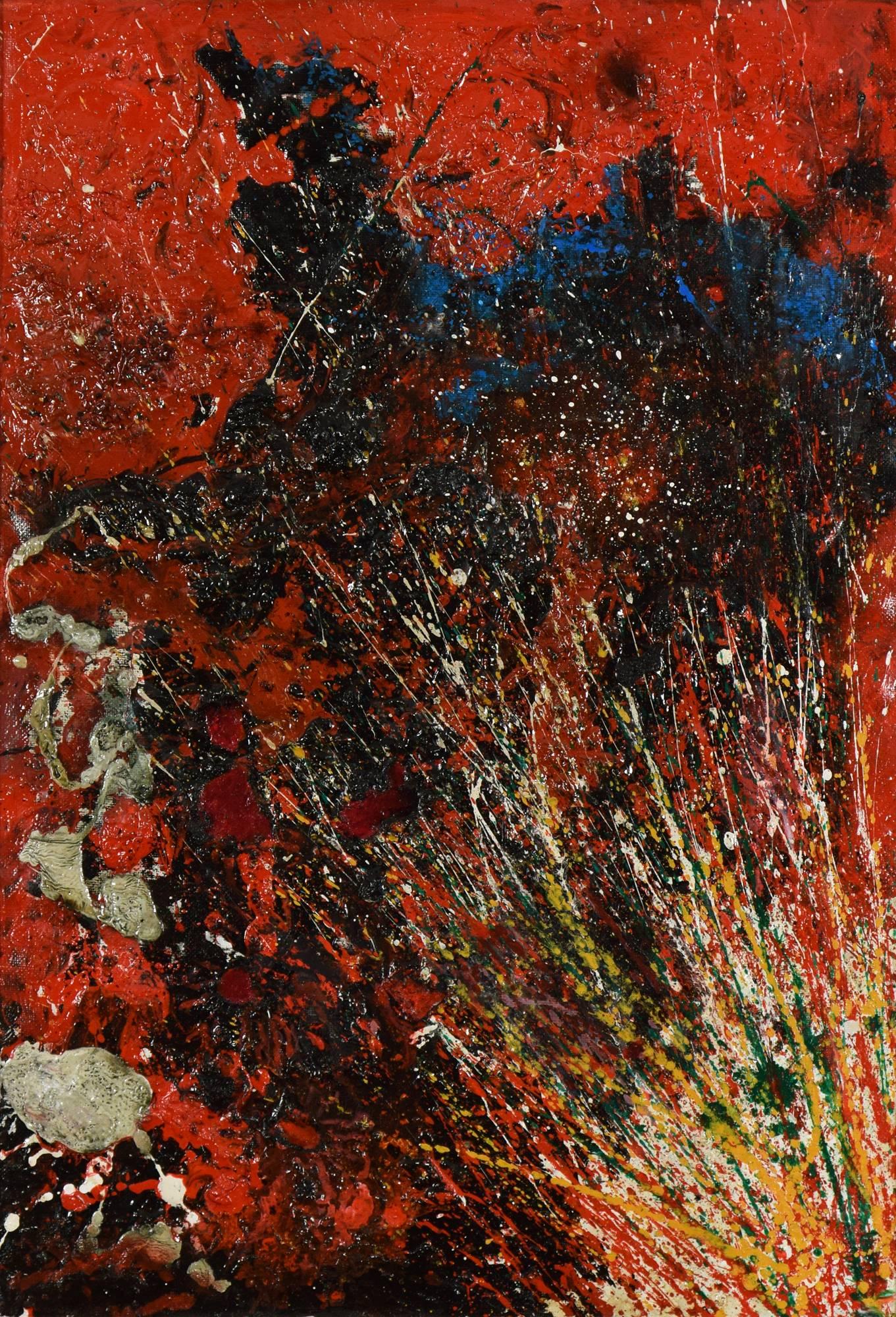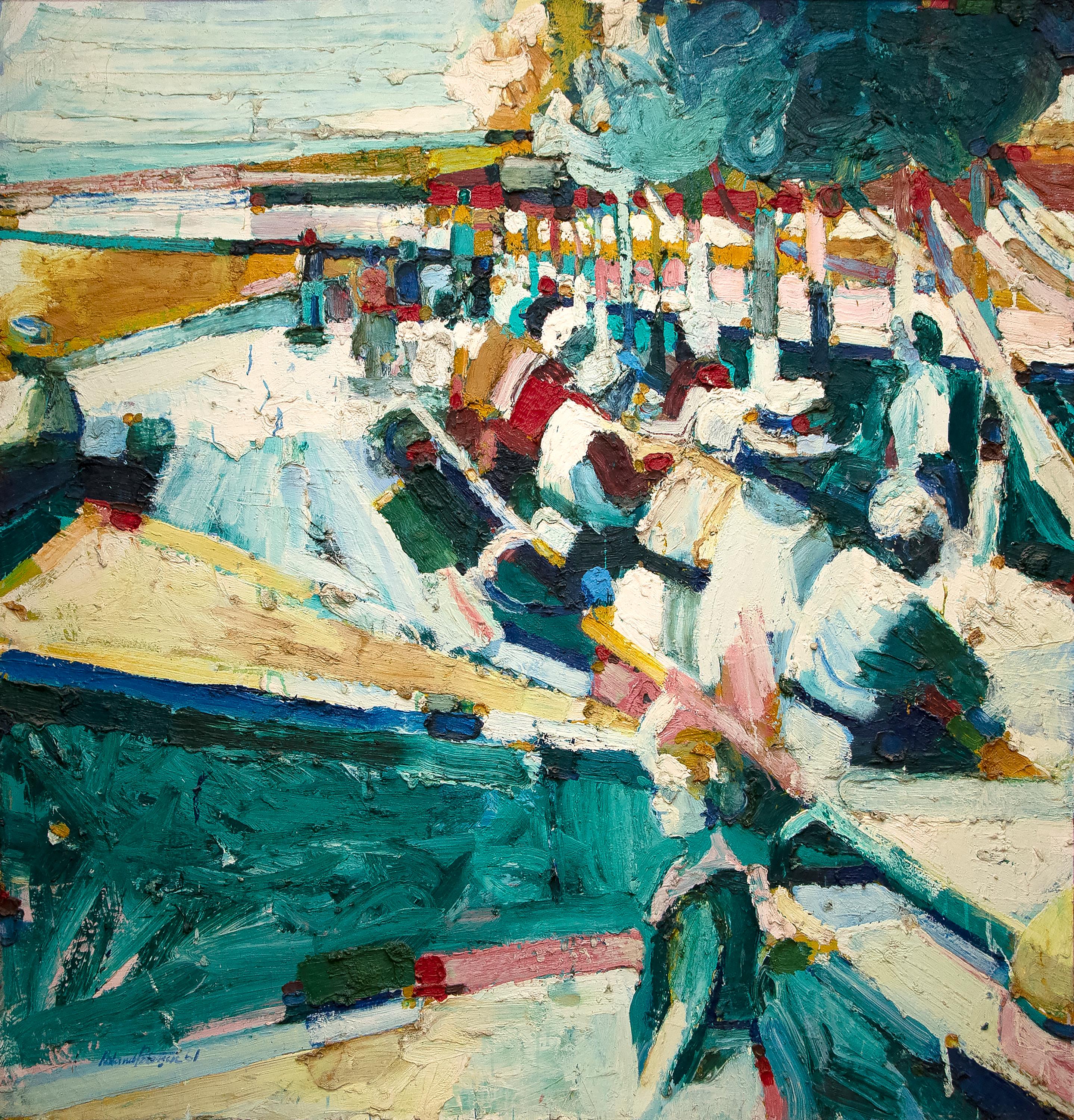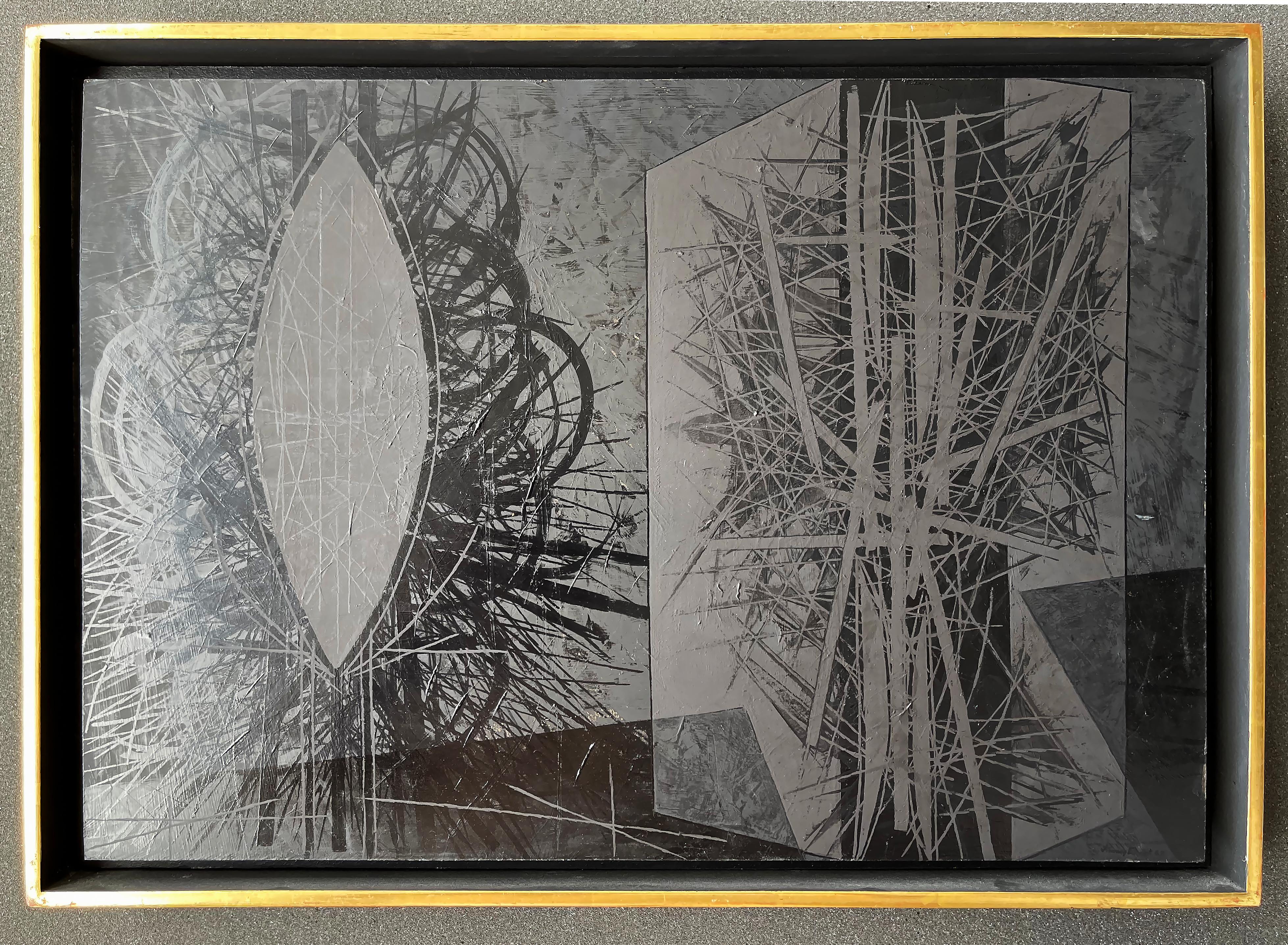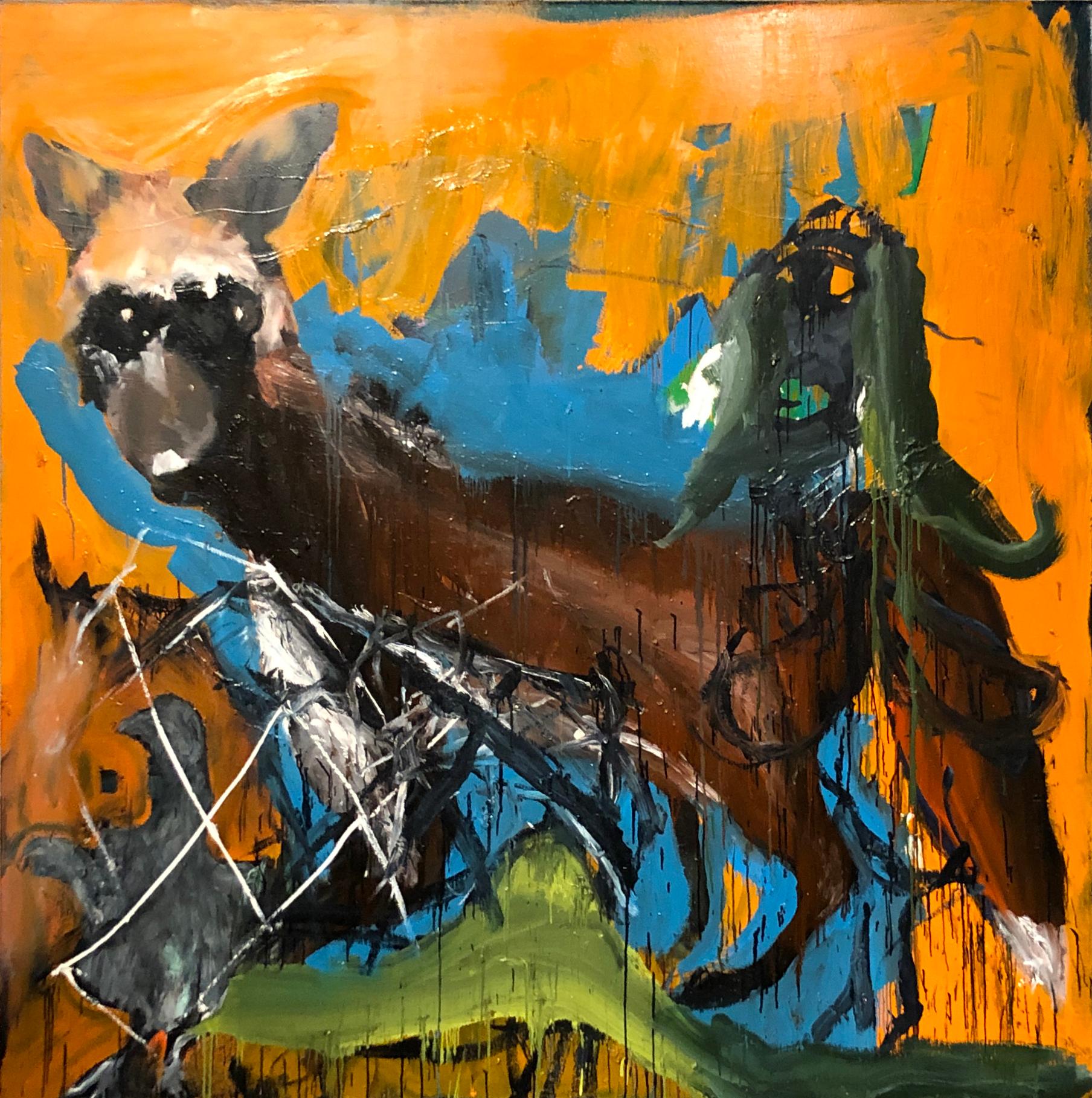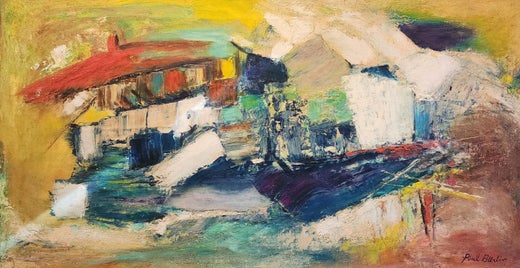Items Similar to Abstract
Want more images or videos?
Request additional images or videos from the seller
1 of 7
Paul BurlinAbstract
About the Item
Signed lower right.
Born in New York City, Paul Berlin was a semi-abstract painter who achieved early success as a landscape, portrait, and mural painter in New York.
His early art education was at the National Academy of Design, and he also studied art in England. In the 1920s, 30s and 40s, he exhibited and lectured widely and was well known nationally.
Inspired by a 1913 visit to the Southwest, he became an early member of the Santa Fe school of western painting and did Indian portraits and landscapes including the Grand Canyon. In the 1912 Armory Show exhibition, he was one of the youngest members in the exhibition and the only painter who had visited the Southwest. However, his abstract, expressionistic style was viewed suspiciously by other painters in the West.
Burlin continued to visit the Southwest, and in 1917 married Natalie Curtis, a woman from New York who had studied in Europe and who subsequently lived in New Mexico and Arizona and devoted herself to preserving the culture, language and traditions of Native Americans. She was especially focused on the songs and chants of the Hopi Indians. Curtis and Burlin lived in Santa Fe, but in 1921, Curtis, age 46, was killed in Paris by an automobile when she and her husband were in Paris attending an International Congress on the History of Art.
Burlin taught at the Art Students League summer school in Woodstock, New York after it was re-established, following World War II, in 1947. He was a member of the American Congress of Artists and was active in the Provincetown Art Colony. He taught at the Colorado Springs Fine Art Center, the University of Wyoming, and Washington University in St. Louis.
A fellow of the MacDowell Colony, in Peterborough, New Hampshire, Burlin was represented in an exhibition in 1997, "Community of Creativity: A Century of MacDowell Colony Artists," that traveled from the National Academy of Design, New York City, to the Wichita Art Museum, Kansas.
In 1962, the Whitney Museum of American Art, New York City, held a retrospective exhibition of Burlin's work.
Collections include the Museum of Modern Art, New York City; Whitney Museum of American Art; Provincetown Art Association and Museum, Massachusetts; and the Museum of New Mexico, Santa Fe.
- Creator:Paul Burlin (1886-1969, American)
- Dimensions:Height: 10.5 in (26.67 cm)Width: 30 in (76.2 cm)Depth: 3 in (7.62 cm)
- Medium:
- Movement & Style:
- Period:
- Condition:
- Gallery Location:Saratoga Springs, NY
- Reference Number:1stDibs: LU170213665902
Paul Burlin
Paul Burlin was born in New York in 1886. He received his early education in England before returning to New York at the age of twelve. He worked for a short time as an illustrator under Theodore Dreiser at Delineator magazine, where he was exposed to Progressivist philosophy and politics. He soon grew tired of commercial work and enrolled at the National Academy of Design. There, he received a formal education and refined his technical skills; though he later dropped out to pursue his artistic studies more informally with a group of fellow students. He was also a frequent visitor at Alfred Steiglitz’s ‘291’ gallery. Burlin achieved a great deal of early artistic success. He visited the Southwest for the first time in 1910. Paintings from this visit were received warmly in New York and exhibited in a 1911 exhibition. As a result of his early success, he (and Randall Davey) were the youngest artists (at twenty-six years of age) to participate in the 1913 Armory Show – the revolutionary exhibition of avant-garde European work that can be credited with introducing modern art to the United States and stimulating the development of modernism in America. There, Burlin’s work was exhibited alongside works by such artists as Picasso, Monet, Cézanne, and Duchamp.
About the Seller
4.2
Vetted Seller
These experienced sellers undergo a comprehensive evaluation by our team of in-house experts.
Established in 1992
1stDibs seller since 2015
30 sales on 1stDibs
Typical response time: 19 hours
- ShippingRetrieving quote...Ships From: Saratoga Springs, NY
- Return PolicyA return for this item may be initiated within 3 days of delivery.
More From This SellerView All
- The FernBy Agnes HartLocated in Saratoga Springs, NYSigned lower right Agnes Hart was born in Meridan, Connecticut. She studied at the Ringling School of Art in Sarasota, Florida; at Iowa State University with Josef Presser, Paul Burlin and Lucile...Category
1940s Abstract Expressionist Abstract Paintings
MaterialsCanvas, Oil
- Abstract and DripBy Rolph ScarlettLocated in Saratoga Springs, NYSigned lower right. Description An example of Scarlett’s abstract drip painting, this untitled work has linear and geometric elements rendered in shades of black, rose, and blue and...Category
1950s Abstract Expressionist Abstract Paintings
MaterialsCanvas, Oil
- AbstractBy Rolph ScarlettLocated in Saratoga Springs, NYSigned lower right and a double sided painting.Category
Mid-20th Century Abstract Expressionist Abstract Paintings
MaterialsOil, Board
- Abstract and Fractured, Biomorphic and Geometric FormsBy Agnes HartLocated in Saratoga Springs, NYSigned lower left. “Abstract and Fractured Biomorphic and Geometric Forms” which was painted in the mid to late 1950’s is a nod to Picasso’s famous painting Guernica, which Hart may have seen when it was given to the Museum of Modern Art in New York in 1958. Several elements in the painting clearly reference Guernica: the black geometric and cut-out shapes, the biomorphic shapes, the abstracted horse’s head and body, with a district reference to the bull’s tail, along with the black and white pallet choice and various details throughout-all hallmarks of Picasso’s Guernica. The abstracted reality Hart presents in these references go beyond a simple nod and reflect a personal interpretation reflected in the splintered abstraction and her bespoke interpretation. Agnes Hart’s first began her career as a social realist artist in the 1930’s. She was also WPA artist. Her longtime friend Milton Avery encouraged her, and she exhibited in the same gallery in the late 1940’s, the RoKo Gallery. Her instinctive and personalized modernist periods often reflected a similar path of her compatriot artists during the first half of the 20th century. Her early works were influenced by her teachers Josef Presser, Paul Burlin and Lucile Blanch, and Reginald Neal, and reflected historical modern trends-at times showing the influence of Avery and other modernist. Like Elaine DeKooning, Lee Kraser, Michael Corrine West...Category
1950s Abstract Expressionist Abstract Paintings
MaterialsCanvas, Oil
- AbstractLocated in Saratoga Springs, NYSigned verso & dated 2013. Dexter Holmes was born in Binghamton, New York in 1986 and is from first generation Italian heritage. His mother and fath...Category
21st Century and Contemporary Abstract Expressionist Abstract Paintings
MaterialsAcrylic
- No ExitBy Enrico DonatiLocated in Saratoga Springs, NYSigned lower right and dated & titled verso. Enrico Donati, a surrealist and abstract expressionist painter, was born in Milan, Italy in 1909 and died in Manhattan on April 25, 2008. He was known for his association with the surrealist movement of the 1940's, but his artwork continued to transform itself through the many trends that have occurred during his long career. In Italy he attended the Universita degli Studi in Pavia where he studied economics. In 1934, he moved to the United States settling in New York where he studied at the New School for Social Research and the Art Students' League. Considered the surviving dean of the Surrealist Movement and a member of the New York School, Donati painted with Ernst, Matta and Tanguy in the thirties and forties, and in particular with Andre Breton, regarded by many to be the grand master of Surrealism. He helped organize the Exposition Internationale du Surrealisme in Paris in 1947 where he exhibited three of his pieces. The Surrealists were known to avoid presenting or representing reality, and put the emphasis on invention and creativity by uncovering the poetic aspect of life with its kaleidoscopic multidimensional images, using reality only to enhance imagination. Donati survived the decline of Surrealism in the late 1940's by adapting his style to current art trends as he worked with new materials and textures throughout the 1950's. One trend with which he became involved was Abstract Expressionism, which originated in the 1940s, and became popular in the 1950s. It was a movement in which artists typically applied paint, rapidly and with force, to large canvases, in an effort to show feelings and emotions. Paint might be applied with large brushes, sometimes dripping or even throwing it onto canvas. Abstract Expressionist work is characterized by a strong dependence on what appears to be accident and chance, although it is actually highly planned. Donati held a retrospective at the Palais des Beaux-Arts in Brussels in 1961 and went on to exhibit at the Betty Parsons Gallery with other forerunners of American Abstract Expressionism: Mark Rothko, Barnett Newman, and Jackson Pollock. It was at this time that Donati created some of his most inventive and extraordinary work, some of which was featured in a survey exhibition at the Alter & Gil Gallery, Beverly Hills, California, in January 2000. He has held many teaching positions and has been an active lecturer, while continuing to add to his artistic repertoire. From 1960 to 1962 he was a Visiting Lecturer at Yale University, and from 1962 to 1972 a Member of the Yale University Council for the Arts and Architecture. He has had seventy-five one-man shows, among them an exhibit of new paintings at the Maxwell Davidson Gallery (57th St., New York) in the fall of 1997. Donati's work is held in collections throughout the world, and his work has appeared in over 300 articles and publications, two hard cover books...Category
1960s Abstract Expressionist Abstract Paintings
MaterialsCanvas, Mixed Media
You May Also Like
- "Manhattan Night Life"By Vaclav VytlacilLocated in Lambertville, NJJim’s of Lambertville is proud to offer this artwork by: Vaclav Vytlacil (1892-1984) He was born to Czechoslovakian parents in 1892 in New York City. Living in Chicago as a youth, he took classes at the School of the Art Institute of Chicago, returning to New York when he was 20. From 1913 to 1916, he enjoyed a scholarship from the Art Students League, and worked with John C. Johansen (a portraitist whose expressive style resembled that of John Singer Sargent), and Anders Zorn. He accepted a teaching position at the Minneapolis School of Art in 1916, remaining there until 1921. This enabled him to travel to Europe to study Cézanne’s paintings and works of the Old Masters. He traveled to Paris, Prague, Dresden, Berlin, and Munich seeking the works of Titian, Cranach, Rembrandt, Veronese, and Holbein, which gave him new perspective. Vytlacil studied at the Royal Academy of Art in Munich, settling there in 1921. Fellow students were Ernest Thurn and Worth Ryder, who introduced him to famous abstractionist Hans Hofmann. He worked with Hofmann from about 1922 to 1926, as a student and teaching assistant. During the summer of 1928, after returning to the United States, Vytlacil gave lectures at the University of California, Berkeley, on modern European art. Soon thereafter, he became a member of the Art Students League faculty. After one year, he returned to Europe and successfully persuaded Hofmann to teach at the League as well. He spent about six years in Europe, studying the works of Matisse, Picasso, and Dufy. In 1935, he returned to New York and became a co-founder of the American Abstract Artists group in 1936. He later had teaching posts at Queens College in New York; the College of Arts and Crafts in Oakland, California; Black Mountain College in North Carolina; and the Art Students League. His paintings exhibit a clear inclination toward modernism. His still lives and interiors from the 1920s indicate an understanding of the art of Cézanne. In the 1930s, his works displayed two very different kinds of art at the same time. His cityscapes and landscapes combine Cubist-inspired spatial concerns with an expressionistic approach to line and color. Vytlacil also used old wood, metal, cork, and string in constructions, influenced by his friend and former student, Rupert Turnbull. He eventually ceased creating constructions as he considered them too limiting. The spatial challenges of painting were still his preference. During the 1940s and 1950s, his works indicated a sense of spontaneity not felt in his earlier work. He married Elizabeth Foster in Florence, Italy, in 1927 and they lived and worked in Positano, Italy for extended periods of time. Later on, they divided their time between homes in Sparkill, New York and Chilmark, Massachusetts, where Vyt, as he was affectionately called, taught at the Martha's Vineyard Art...Category
1930s Abstract Expressionist Abstract Paintings
MaterialsCanvas, Oil
- Red Composition by TOSHIMITSU ÏMAI - Contemporary, Abstract, Oil on canvasBy Toshimitsu ImaiLocated in London, GB*PLEASE NOTE UK BUYERS WILL ONLY PAY 5% VAT ON THIS PURCHASE. Red Composition by TOSHIMITSU ÏMAI (1928-2002) Oil on canvas 80.2 x 55.3 (31 ⅝ x 21 ¾ inches) Signed, TOSHIMITSU IMAÏ, dated, 1963 Paris and inscribed in Japanese on the reverse Provenance Private collection, USA Born in Kyoto, Japan in 1928 Imai was part of the 20th century Japanese avant-garde. He began his formal education at the Tokyo State Art Academy where he took up painting. His early works are characterised by colourful abstractions, reminiscent of Favuism. In 1951 Imai was awarded the Kansai-Shinseisaku Prize and in 1952 the prize for the best new artist at the 15th Shinseisaku Salon. Imai relocated to Paris in 1953, the same and subsequent year he exhibited at the Salon de L’Art Sacré. Meanwhile, he attended the Académie de la Grande Chaumière and the Sorbonne to read medieval history and philosophy. In 1955, Imai completely abandoned representational art in favour of abstraction. After meeting the art critic Michel Tapié via the artist Sam Francis, Imai was the first Japanese artist to join the Art Informel movement. In 1956 Imai was called upon by the Japanese artist Taro Okamoto to curate an exhibition entitled The World: Today’s Art in Tokyo. Artists such as Jean Dubuffet, Jean Fautrier, Lucio Fontana, and Karel Appel gained important exposure in Japan. It was also in 1957, when Imai arranged for Tapié and the artists Georges Mathieu and Sam Francis to travel to Japan, that a connection between Art Informel and Gutai occurred. The Ashiya-based Gutai Art Association formed in 1954 was proclaimed a kindred spirit by Tapié which he subsequently promoted internationally. Founding members included Yoshihara Jiro, Kanayma Akira, Murakami Saburo, Shiraga Kazuo and Shozo Shimamoto...Category
1960s Abstract Expressionist Abstract Paintings
MaterialsCanvas, Oil
- UntitledBy Roland PetersenLocated in Palm Desert, CAA painting by Roland Petersen. This Untitled, oil on canvas, abstract painting is executed in thick and lush impasto, in colors primarily of greens, blues, teals, white, red, ochre a...Category
1960s Abstract Expressionist Abstract Paintings
MaterialsCanvas, Oil
- Summer Ocean - Oil Paint by Elena Mardashova - 2023Located in Roma, ITOriginal oil Painting on canvas 60X50 cm, called Summer Ocean, is created to bring the feeling of the summer sea, fresh air and transparent clear water. Excellent condition.Category
2010s Abstract Expressionist Figurative Paintings
MaterialsCanvas, Oil
- Black on Black #4By Jimmy ErnstLocated in Miami, FLThe artist has painted the work in matte black and gloss black. It a sense this is also an optical art “Op Art” in that it changes as the light changes. Jimmy Ernst was a major figure of the New York School of abstract painting and part of The Irascibles, and son of Max Ernst: Provenance: Grace Borgenicht Gallery, New York, New York; Joseph H. Hirshhorn, New York and Washington, D.C. (acquired from the above in 1966); Joseph H. Hirshhorn bequest, Hirshhorn Museum, Washington, D.C., 1981; Sotheby's Arcade, New York, New York, February 24, 1995, lot 331; The Jeanne and Carroll Berry...Category
1960s Abstract Expressionist Abstract Paintings
MaterialsEnamel
- Hot Fox in the Henhouse - Large Scale Abstract Expressionist PaintingBy Wesley KimlerLocated in Chicago, ILWesley Kimler (born 1953) an American artist based in Chicago, Illinois, is known for his colossal paintings, up to 15 feet high and 27 feet wide. According to critic Kevin Nance, th...Category
2010s Abstract Expressionist Abstract Paintings
MaterialsCanvas, Mixed Media, Oil
Recently Viewed
View AllMore Ways To Browse
Painting St Paul
Colony New York
Provincetown Art
Paul Berlin
Modern Southwest Art
Arizona Painter
Native American War Art
Southwest New Mexico Art
Paul Whitney
Western Indian Art Painting
Indian Western Art
Provincetown School
Southwest New Mexico Paintings
Art Frame Automobile
Indian War Paintings
Provincetown Vintage
Kansas City History
Mexican Art 1920s
